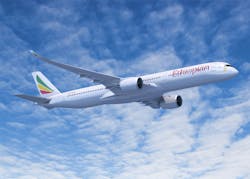Ethiopian Airlines Group, the flag carrier of Ethiopia, has upsized four of its Airbus A350-900 on order to the largest variant of the A350 family, the A350-1000, becoming Africa’s first customer for the aircraft.
Ethiopian Airlines has already ordered 22 A350-900s, of which 16 aircrafts have been delivered. With the A350-1000 upsizing, Ethiopian Airlines’ backlog consist of four A350-1000 and two A350-900s.
Ethiopian Airlines Group CEO Mesfin Tasew said, “We are delighted over the upsizing of the A350-900 on order to the largest variant, A350-1000, that helps us stay ahead of the curve in technology. We are the technology leaders in the continent introducing the latest technology and fuel-efficient fleet into Africa. The A350-1000 is the best fit for our dense routes, and we believe that the upsizing will be instrumental in satisfying the increasing demand of customers in our vast global network across five continents. We will continue keeping ourselves abreast of aviation technology advancements to enhance our service and fulfill customers’ demand.”
“We are proud of our strong partnership with Ethiopian Airlines – the first airline in Africa to order and operate the A350-900. In another first, Ethiopian Airlines is once again leading the way in Africa’s aviation sector by introducing the A350-1000, the largest version of the world’s most efficient and technologically advanced passenger aircraft,” said Mikail Houari, president, Airbus Africa and Middle East. “The A350-900 has delivered extraordinary capability, fuel efficiency, and operational reliability of 99.5 percent together with unbeatable operational flexibility and efficiency, from short to ultra-long-range operations.”
The A350-1000 will increase the East African carrier’s capacity and it will be an addition to its modern wide-body fleet.
The airbus A350’s clean-sheet design features state-of-the-art aerodynamics, a carbon fiber fuselage, and wings, plus the most fuel-efficient Rolls-Royce Trent XWB engines. Together, these latest technologies translate into unrivalled levels of operational efficiency and sustainability for Ethiopian Airlines, with a 25% reduction in fuel burn and CO2 emissions compared to previous generation twin-aisle aircraft.


